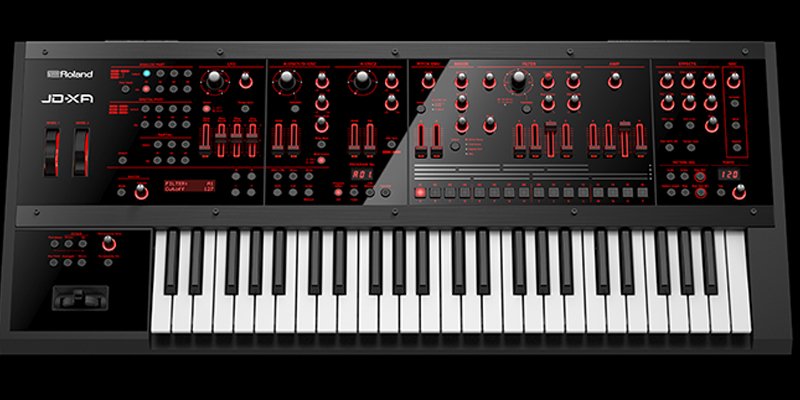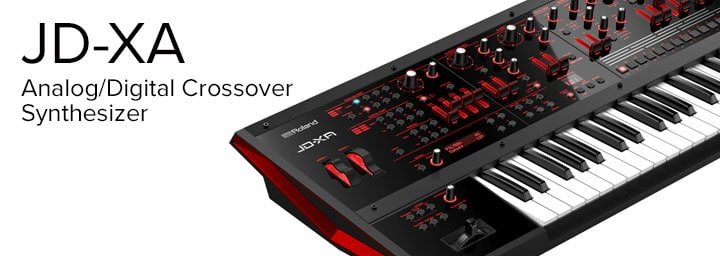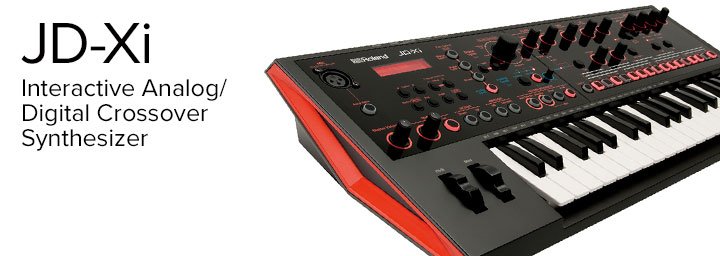The Roland JD-XA is a crossover synth with four analog and four digital voices. It looks similar to the Roland JD-Xi Interactive Analog/Digital Crossover Synthesizer, but they are two very different instruments. The JD-Xi is an all-in-one groove machine with two digital voices, one analog voice and drums. The JD-XA; however, is a synthesis powerhouse that can layer a wide variety of digital and analog sounds. The most obvious difference between the two is that the JD-XA does not have drums. However, that doesn’t mean that it can’t make drum sounds! Both the analog and digital synth engines in the JD-XA are capable of creating drums sounds. Here are six tips to help you create your own drum sounds with the JD-XA.
Contributed by Roland Canada
Tip 1: Create a TR-808 Style Kick
The famous kick of the TR-808 is based on a specific type of bandpass filter circuit (Twin-T). The filter has a very high resonance. When a trigger pulse is sent to the filter, it causes it to self-oscillate, creating a decaying sine wave tone. Both the analog and digital bandpass filters in the JD-XA can self-oscillate. This means that they can be the tone source for a TR-808 style kick. Adjust the amplifier envelope to have a short decay and tune the drum using the filter cutoff. You can also add a bit of pitch decay using the filter envelope. Add some drive and pink noise to help cause the filter to oscillate.
Tip 2: Create an Oscillator-Based Kick and Tom
Since the self-oscillating filter in the TR-808 creates a sine wave, one of the JD-XA’s oscillators can be used to create a kick or tom. The oscillators in the JD-XA have a dedicated envelope, which is perfect for creating synthesized toms. Adjust the amp envelope to a short decay and start making drum sounds.
Here are some tips for getting various tones out of this method:
- Drive: Increase the drive to the filter for a distorted/overdriven sound.
- Triangle: Change the waveform from sine to triangle for a more aggressive sound.
- Noise: Add some noise to the mix and filter it out with a low-pass filter that has an envelope with a very short decay. This will create a click, similar to the Attack control on the TR-8.
- Resonance: Add resonance to the filter along with some envelope modulation. This will add a zap to the sound.

Tip 3: Create Filtered Noise Hi-Hats
Hi-hats are the easiest drum sound to create. Send white noise through a high-pass filter and use a short decay on the amp envelope. Use less decay for a closed sound and more decay for an open sound.
Tip 4: Create a Snare
A snare sound can be created by using a combination of both the hi-hat method and oscillator based tom sounds. Start by creating an oscillator based tom, and then add white noise. Filter the sound with a band-pass filter, then use a short decay on the amplifier envelope. Play with the mix of the oscillator and noise to get the desired amount of snap.
Tip 5: Create Digital Source
Try layering digital bell and percussive tones to create a unique drum sound. There is even a cowbell (tone 293) that can be used on its own. Percussive rhythms can always use more cowbell!
Tip 6: Create an LFO Rhythm
The LFO can be used as a modulation source to create a simple drum rhythm. This way, the entire drum kit can be created in just one digital part. Start by turning on the LFO key trigger and enabling LFO sync for each of the three partials. Set the LFO shape to saw for all three partials. Set the rate of the LFO to 1/4 on the first partial, 1/2 on the second and 1/8 on the third. This provides the modulation sources for the kick, snare and hi-hats. Use the drum synthesis methods mentioned above, but use the LFO instead of envelopes.
Related Articles
7 ESSENTIAL SYNTH TUTORIALS
ESSENTIAL SYNTH TUTORIALS: PART 2
JD-XI: WHICH COLOUR DO YOU LIKE?





